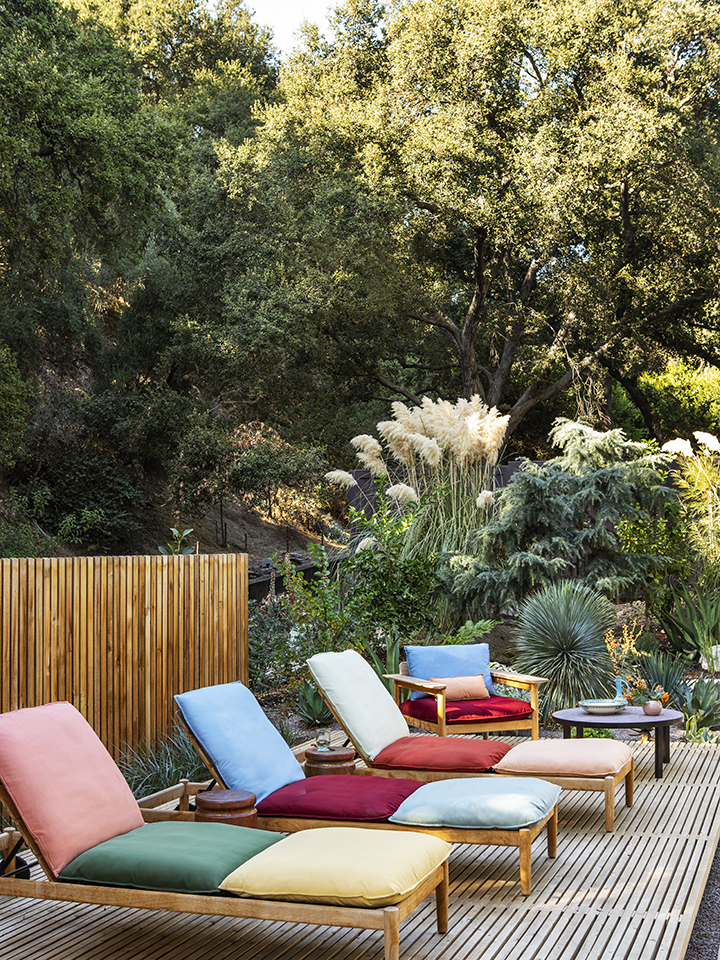We may earn revenue from the products available on this page and participate in affiliate programs.
Did you leave your outdoor sofa cushions in the rain a few too many times? Are your sun loungers looking a little faded and your balcony chairs as comfortable as hard pavement? There’s nothing a few yards of waterproof fabric can’t fix. “People are often just wanting to spruce up their current setups, so we’re making a lot of new covers for sofas, chairs, and chaises and creating padding for uniquely shaped seating areas,” says Ella Hall, cofounder of Stitchroom, an online upholstery startup. With that in mind, we rounded up six projects to DIY (or take to a pro) that will give your exterior a whole new look.
Hang Curtains
Whether you’re looking to infuse some peace and quiet to a sprawling veranda or privacy to a tiny balcony, drapes are the answer. Plus the billowing panels will give a breezy vibe that will make you feel like you’re on vacation.
Keep in mind: Unlike indoors, these curtains will likely have to be hung from the ceiling, so measure their height accordingly. Add 15 inches and divide the total number by 36 to get the total yardage you’ll need. For example, if you need a 90-inch-long curtain, you would add 15 inches (which equals 105 inches) and divide by 36 to get to 2.91 yards (which rounds up to 3).
DIY difficulty level: Intermediary. If you’ve hung curtain rods before and know how to sew, you can probably do this yourself.
Make Your Own Table Linens
Sure, you could go and buy a ready-made tablecloth, but crafting one out of your favorite fabric (or a leftover textile from an old project) will take the ambience of your alfresco meals to the next level. You can also sew napkins, placemats, or a runner to match.
Keep in mind: Hall notes that a table that seats six people (which is approximately 36-by-60 inches) will require 3 yards of fabric.
DIY difficulty level: Easy. All you need is a sewing machine to tidy up the edges.
Cover a Dingy Sofa
Don’t just kick outdoor upholstery that’s looking worse for wear to the curb. Even inexpensive hardware-store lounge furniture can be elevated with new upholstery.
Keep in mind: A standard 75-inch sofa with four cushions requires approximately 8 yards of fabric (or 2 yards per cushion), says Hall. For pool loungers, plan to use approximately 4 yards per chair; 5 if the textile is patterned.
DIY difficulty level: Expert. Not only will you have to carefully measure each cushion so that it fits snug on the inserts, but you may also have to be well versed in piping to give your piece a finished look. You might want to take this project to a pro unless you really know what you’re doing.
Give Your Seats Some Extra Padding
Wrought-iron patio chairs might look pretty, but they’re not always comfortable to sit on. The solution: seat cushions. Yours will be so plush you’ll consider turning your terrace into a temporary office—as long as you have enough shade, that is.
Keep in mind: Aim for 1 yard of fabric per chair.
DIY difficulty level: Easy. Buy ready-made inserts to simplify the project even more and simply sew a cover with ties that line up with the back of your chair.
Hide Old Furniture Frames
Not to be confused with a tablecloth, a skirt will mask any unsightly table from top to bottom. Cover a console, for instance, and use it as a makeshift bar or buffet table.
Keep in mind: Measure the perimeter of the table, multiply it by 1.5, and divide by 36 to figure out your required quantity. For example, a 36-by-60-inch table with a perimeter of 192 inches would equal 288 inches. Divided by 36, that’s approximately 8 yards of fabric.
DIY difficulty level: Intermediary. This is a relatively simple project that requires attaching five panels of fabric together, but you’ll want to be precise to make sure it fits properly and lines up with the ground. Measure twice before cutting into your pattern.
Create More Seating
Even better than regular throw pillows are floor cushions, which are easy to move around and can be used as seats, makeshift tables, or merely back support. “If you’re a city dweller like I am, they can be a godsend for summer rooftop sitting,” says Hall. “I’ve started storing several in my closet and bringing them up with a blanket to create a little picnic experience.”
Keep in mind: Smaller seat pillows call for three-fourths of a yard per piece, while larger floor ones need a whole one.
DIY difficulty level: Easy. Buy your inserts and sew the rest by combining two square panels together and leaving a zipper opening on one side. Psst: You don’t even need a patio—bring a cushion to the beach or park, or even throw one on your fire escape to enjoy the breeze.
It’s hammer time: Follow @reno_notebook for easy rental updates, clever DIYs, and tips to nail your next project.
